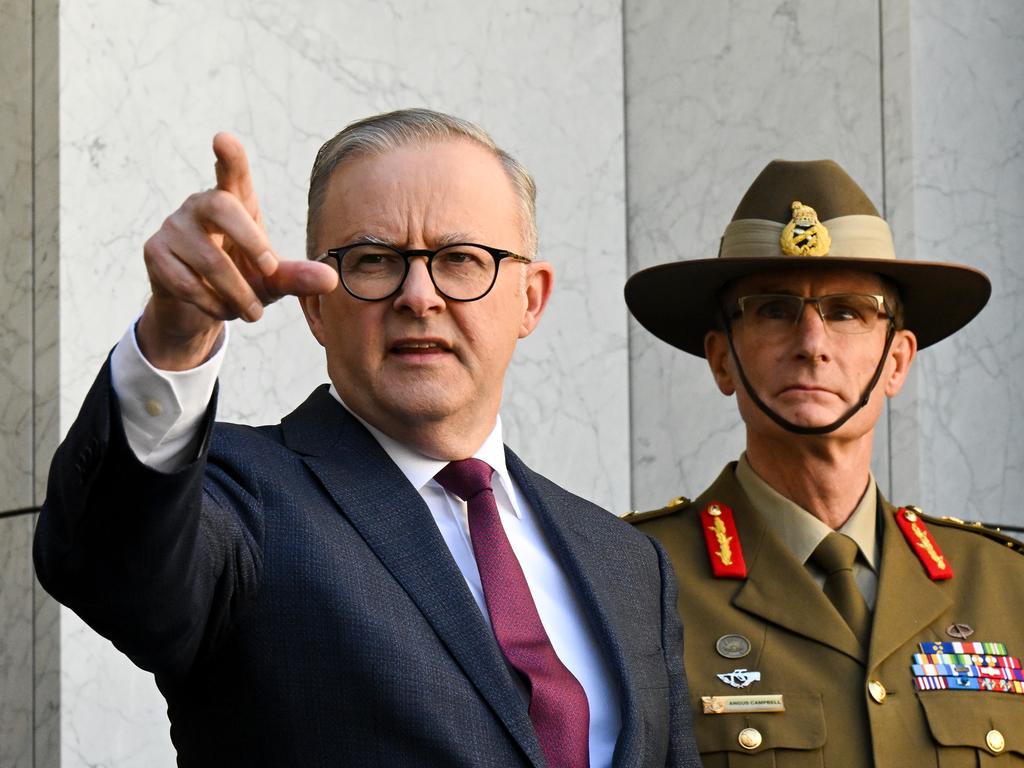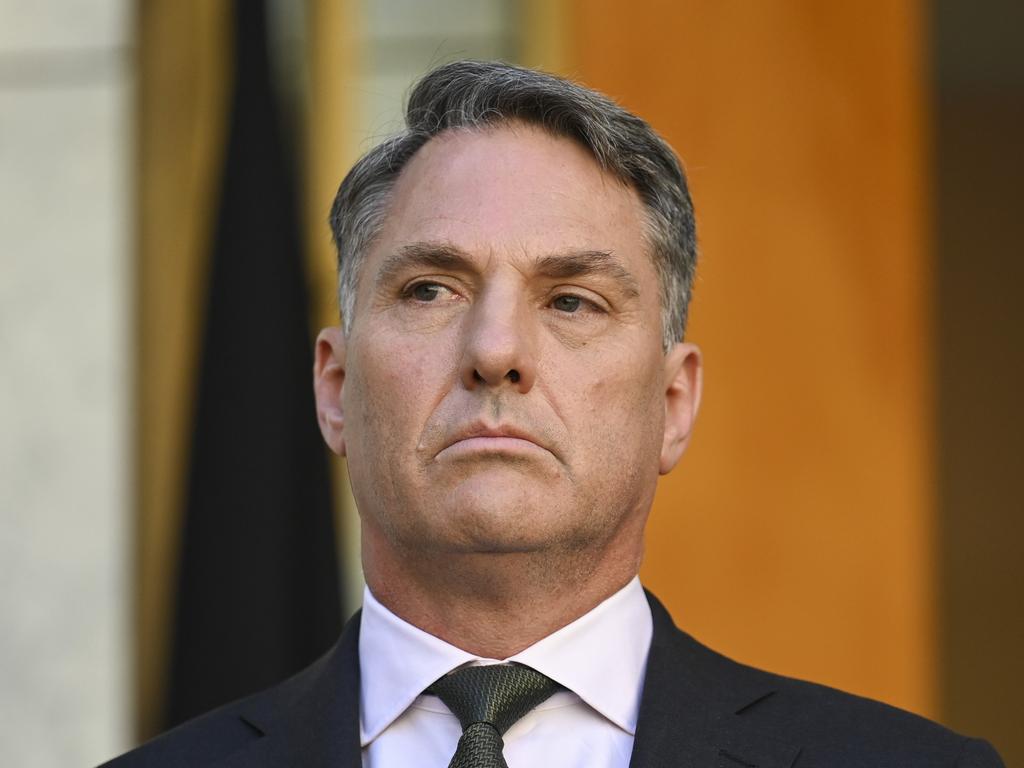What’s the point of the Defence Strategic Review if we need yet more reviews?


The big reforms announced are in the army, which will move from being structured for land operations as a niche force with the US, to a more agile force, something like the American marines, which can operate on our coasts and in the island archipelago to our north, with greater emphasis on missiles.
Funding keeps faith with the government’s electoral commitments. Spending will at the least match the trajectory outlined by the Morrison government, rising marginally above 2 per cent of gross national product. Some wasteful expenditure will be cut, especially in the army’s heavy armour, and redirected at higher priority programs.
There will be further capability announcements in coming days. These might include hardening and expanding our northern military bases. There will probably be announcements about smart sea mines. Perhaps something on drones and expanded naval facilities in Perth.
The theology of the DSR, so to speak, is sound. It suggests Australia will move from a “balanced force” to a “focused force”. A balanced force can do a little bit of everything but not much of anything, while a focused force makes an effort to be effective in a few key tasks.

The DSR is frank about the danger and challenge posed by China’s military build-up.
It was by no means inevitable that a Labor government in a time of left-wing dominance would be as good as this. It will certainly be no worse than the Coalition government it replaced.
However, there is also a great deal to be disappointed about in the DSR and the government’s response, at least so far. It’s possible there’s a lot more stuff in the classified version.
One of the strangest decisions is to announce a new review – yes that’s right, yet another review – into the shape of Australia’s naval surface fleet. After countless billions of dollars and more reviews than hot meals, our navy has just three modern surface warships, the air warfare destroyers.
The AWDs are hardly the deadliest ships at sea. (Way back when, the government should have gone with the Arleigh Burke-class destroyers, reportedly John Howard’s preference.) But at least the AWDs can fire lethal missiles at enemies and have a chance of defending themselves from incoming fire.
Yet we are doing nothing to procure modern surface warships. We’re going to have a new review that will report in the third quarter this year. This is extremely perplexing on three fronts.

What was the point of the DSR if we just have to have a new set of reviews? The DSR determined, rightly, that modern navies are moving towards a larger number of smaller ships. We have almost no ships and the ones we do have don’t have any firepower. And although the Hunter-class frigates we’re building are very big, they have a tiny missile capability.
Everybody expects we’ll cap the planned 12 offshore patrol vessels at six and build at least six corvettes, mini frigates, which are real warships and which you can load up with missiles. And that we’ll cut the Hunter order from nine to six and build or buy three more AWDs or their equivalent. Those two moves together would give us a lot more missiles.

But this conclusion was reasonable and predicted 11 months ago. What benefit is there to spend another three or six months and come to the same conclusion? The net result will be 18 months wasted.
And if we can’t do anything quickly because we’ve got to get through the six OPVs and the six Hunters first, then we are really declaring that we can’t respond meaningfully to our strategic challenges in the next decade.
There is a fundamental contradiction between the urgency of our strategic circumstances and the slow pace of response.
There’s no guarantee a new review won’t end up recommending not that we go to preferred and proven suppliers to get the corvettes and the AWDs but that we embark on a new tender process. Yet more delay.
The second problem is one of process. The whole point of having a DSR by Stephen Smith and Angus Houston was that they could take an overall view of the nation’s defence needs and make bold, swift, independent recommendations, beyond service traditions or bureaucratic practice.
Instead we end up with them not making the decision at all but the whole thing just going off into another arcane Defence process.
And the third problem with the new review is that the DSR was meant to be conducted with the real-time knowledge and involvement of the Defence establishment so that it could move quickly, if the government wanted it to, on the DSR’s conclusions. Now we find Defence still has to cost the DSR’s recommendations and pick which ones it wants to spend money on.
This merry-go round never ends.
Then there’s the DSR’s strange silence on the air force. Obviously we don’t have enough pilots, but we surely need more high-speed jet fighters. Instead it looks like we’ll stay with the old number we’ve always had.
This is beginning to look a lot like a standard defence outcome.
Surely the weirdest decision, most disheartening decision, is that we will continue to spend billions of dollars on tanks.
We cut the infantry fighting vehicles from 450 to 129, and we halved the number of self-propelled howitzers. There is perhaps a 5 per cent chance we’d ever deploy the IFVs. There is absolutely zero chance we’ll ever deploy the tanks.
The tanks are half as heavy again as the IFVs. We can’t transport them anywhere. The nearest thing to a hypothetical scenario for using a tank is if a hostile power had a military base in the South Pacific and we needed to dislodge it by force.
That would mean, though, that we couldn’t bomb it or missile it. To need tanks, our forces would have to be operating against enemy fire.

That means, logically, that we’d have to do an opposed maritime invasion, with our superheavy tanks that we can transport one at a time, and that our enemy would accommodate us by not possessing the missiles that could destroy the undefended ships on which we would take our lumbering tanks, which couldn’t operate anyway if it was rainy season or they had to cross bridges.
I’m no fan of the IFVs. But they are infinitely preferable to tanks. The army’s victory on tanks, like the strange lack of urgency around everything to do with force acquisition, speaks to the epic, imperturbable majesty of defence culture, which transforms paralysis from an affliction into an operating principle.
The real victor here is the self-satisfied, heroically unhurried tradition of the Australian Defence establishment.
Nothing, absolutely nothing, changes that.







The Albanese government has got the direction and rhetoric of defence reform right in the Defence Strategic Review.